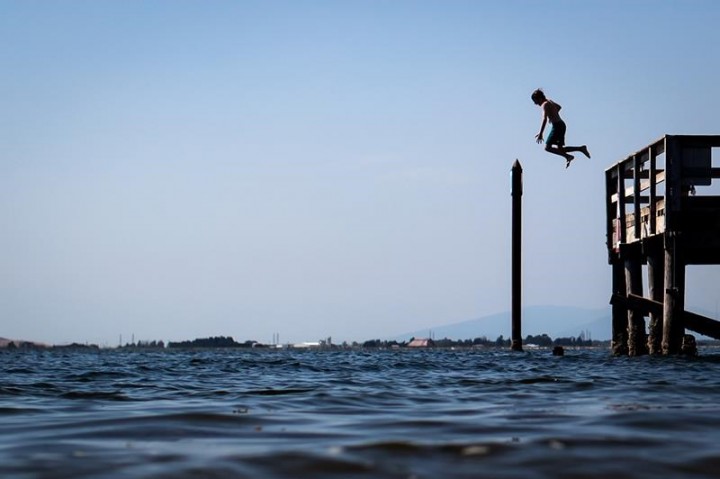Environment Canada heat warnings covered most of British Columbia one year ago as a so-called heat dome settled in and became deadly.
The weather office described the heat dome as a strong ridge of high pressure, which trapped stagnant air like a lid over the province amid drought conditions.
The provincial coroners’ service linked more than 600 deaths to the extreme heat, with 93 per cent of them occurring during the week of June 25 to July 1.
The first warnings came as temperatures began to rise on June 24, 2021. The average daytime high for this time of year in B.C. is around 22 C, but temperatures soaring into the 30s were predicted.
June 24: Environment Canada issues warnings about extreme temperatures starting the next day for almost all of B.C. The weather office says the risk of wildfires and potential for illness linked to heat or poor air quality will likely rise.
June 25: B.C.’s Ministry of Public Safety releases a statement asking residents to take precautions over the weekend as Environment Canada predicts a “dangerous, long heat wave” with little relief at night. The ministry provides tips for staying safe and cool, including drinking plenty of water, staying in air-conditioned spaces or taking a cool bath or shower and regularly checking on vulnerable people.
June 26: An air quality advisory is issued for eastern parts of Metro Vancouver and thecentral Fraser Valley, prompted by high concentrations of ground-level ozone that form when pollutants from burning fossil fuels react with sunlight.
June 27: Sixty daily temperature records fall in communities across B.C. The mercury in the southern Interior village of Lytton climbs beyond 46 C, breaking the all-time Canadian high of 45 C set in Saskatchewan in 1937. Environment Canada describes the heat wave as “prolonged, dangerous, and historic.”
Power utility BC Hydro says it logged a new record for peak hourly demand during the summer over the previous night. It says peak demands are usually recorded on weekdays, making the overnight record even more striking.
June 28: Lytton sets another Canadian temperature record at 47.9 C, while more than a dozen school districts across B.C. cancel classes for the day due to the heat.
June 29: Environment Canada says 91 maximum daily temperatures and 181 warm overnight low temperatures are broken across B.C., Alberta, Yukon and the Northwest Territories. It says many daily records were shattered by five to 10 degrees.
The temperature in Lytton sets yet another Canadian heat record, which still stands today, reaching 49.6 C.
B.C.’s chief coroner, Lisa Lapointe, issues a statement saying there has been a “significant increase” in deaths, with heat believed to be a contributing factor.
June 30: A wildfire moves through Lytton “with ferocious speed,” giving residents minutes to get out, Mayor Jan Polderman later tells media.
The extreme heat eases for parts of B.C., Yukon and the Northwest Territories, but Environment Canada warns that conditions remain dangerously hot across southern and central B.C. and stretching east to Manitoba.
B.C. Public Safety Minister Mike Farnworth says the government would look at including heat waves in the Emergency Program Act, which guides responses to natural disasters. He defends the government response to the heat dome, saying the province had never seen such extreme heat and emergency management officials had warned communities about the need for cooling stations and other measures.
July 2: Chief coroner Lisa Lapointe says it’s believed two people died in the wildfire that swept through Lytton, and it wasn’t yet safe to search for their bodies. Lapointe also reports that the number of sudden and unexpected deaths during the heat wave was three times what it would normally be over the same seven-day period.
June 6, 2022: B.C. officials announce that a two-stage response system will be launched to help people stay safe as temperatures rise, with heat warnings and extreme heat emergency alerts.
The province also announces the development of an extreme heat preparedness guide to help people get their homes ready for heat waves, while adding more paramedics and vehicles to B.C.’s ambulance system to respond to expected increases in 911 calls during a heat emergency, Farnworth tells a news conference.
June 7, 2022: Thecoroner’s death review panel report into the extreme heat shows more than half of the 619 deaths happened on June 28 and 29, the days with the highest temperatures.
The review found there was a “lag” between the heat alerts issued by Environment Canada and the response by public agencies and includes a series of recommendations for the province to better prepare for extreme heat in the future.
This report by The Canadian Press was first published June 24, 2022.
The Canadian Press
